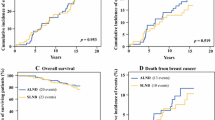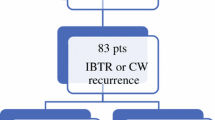Abstract
While any study can be criticized, the results of Z0011 clearly show that sentinel lymph node biopsy (SLNB) alone without axillary lymph node dissection (ALND) results in extremely low locoregional recurrence and excellent overall survival comparable to completion ALND. The observed results in this trial with SLNB alone were excellent. A prospective randomized study with results such as Z0011 should alter therapy. The skilled clinician must utilize his or her experience and the prospective randomized data of this study to improve patient care for women with breast cancer. On the other hand, ALND continues to be the standard of care for positive nodes in the axilla, with lymph node status as the most important prognostic indicator in overall survival (OS) and disease-free survival (DFS) in the management of early stage breast cancer. The advent of sentinel lymph node resection (SLNR) is challenging this notion. There is evidence to support the need for regional control of the axilla as a preventative means for locoregional recurrence and improvement in DFS. ALND is both a diagnostic and therapeutic approach that not only decreases rates of locoregional recurrence, but also guides further treatment strategies. Currently, there are no definable criteria that completely prevent patients from benefiting from ALND in the setting of metastatic disease to the axilla. It is, therefore, clear that ALND should be strongly considered in the management of the SLN-positive axilla. SLNR has its role in the management of early stage breast cancer, but whether SLNR alone should replace ALND is yet to be determined.
Similar content being viewed by others
References
Halsted WS (1894) The results of operations for the cure of cancer of the breast performed at the Johns Hopkins Hospital from June 1889 to January 1894. Ann Surg 20:497–555
Giuliano AE, Kirgan DM, Guenther JM et al. (1994) Lymphatic mapping and sentinel lymphadenectomy for breast cancer. Ann Surg 220:391–8; discussion 398–401
Giuliano AE, Hunt KK, Ballman KV et al (2011) Axillary dissection vs no axillary dissection in women with invasive breast cancer and sentinel node metastasis: a randomized clinical trial. JAMA 305:569–575
Fisher B, Jeong JH, Anderson S et al (2002) Twenty-five-year follow-up of a randomized trial comparing radical mastectomy, total mastectomy, and total mastectomy followed by irradiation. N Engl J Med 347:567–575
Giuliano AE, Hawes D, Ballman KV et al (2011) Association of occult metastases in sentinel lymph nodes and bone marrow with survival among women with early-stage invasive breast cancer. JAMA 306:385–393
Wiechmann L, Sampson M, Stempel M et al (2009) Presenting features of breast cancer differ by molecular subtype. Ann Surg Oncol 16:2705–2710
Moore MP, Kinne DW (1996) Is axillary lymph node dissection necessary in the routine management of breast cancer? Yes. Important Adv Oncol 245–50
Clarke D, Newcombe RG, Mansel RE (2004) The learning curve in sentinel node biopsy: the ALMANAC experience. Ann Surg Oncol 11:211S–215S
McMasters KM, Wong SL, Chao C et al. (2001) Defining the optimal surgeon experience for breast cancer sentinel lymph node biopsy: a model for implementation of new surgical techniques. Ann Surg 234:292–9; discussion 299–300
Krag DN, Anderson SJ, Julian TB et al (2010) Sentinel-lymph-node resection compared with conventional axillary-lymph-node dissection in clinically node-negative patients with breast cancer: overall survival findings from the NSABP B-32 randomised phase 3 trial. Lancet Oncol 11:927–933
Ashikaga T, Krag DN, Land SR et al (2010) Morbidity results from the NSABP B-32 trial comparing sentinel lymph node dissection versus axillary dissection. J Surg Oncol 102:111–118
Pazaiti A, Fentiman IS (2011) Which patients need an axillary clearance after sentinel node biopsy? Int J Breast Cancer 2011:195892. doi:10.4061/2011/195892
Gill G (2009) Sentinel-lymph-node-based management or routine axillary clearance? One-year outcomes of sentinel node biopsy versus axillary clearance (SNAC): a randomized controlled surgical trial. Ann Surg Oncol 16:266–275
Mansel RE, Fallowfield L, Kissin M et al (2006) Randomized multicenter trial of sentinel node biopsy versus standard axillary treatment in operable breast cancer: the ALMANAC trial. J Natl Cancer Inst 98:599–609
Fisher B, Montague E, Redmond C et al (1980) Findings from NSABP Protocol No. B-04-comparison of radical mastectomy with alternative treatments for primary breast cancer. I. Radiation compliance and its relation to treatment outcome. Cancer 46:1–13
Giuliano AE, McCall L, Beitsch P et al. (2010) Locoregional recurrence after sentinel lymph node dissection with or without axillary dissection in patients with sentinel lymph node metastases: the American College of Surgeons Oncology Group Z0011 randomized trial. Ann Surg 252:426–32; discussion 432–3
Latosinsky S, Berrang TS, Cutter CS et al (2012) CAGS and ACS evidence based reviews in surgery. 40. Axillary dissection versus no axillary dissection in women with invasive breast cancer and sentinel node metastasis. Can J Surg 55:66–69
Tjan-Heijnen VC, de Boer M (2009) Minimal lymph node involvement and outcome of breast cancer. The results of the Dutch MIRROR study. Discov Med 8:137–139
Pepels MJ, de Boer M, Bult P et al (2012) Regional recurrence in breast cancer patients with sentinel node micrometastases and isolated tumor cells. Ann Surg 255:116–121
Whelan T, Olivotto I, Ackerman J (2011) NCIC-CTG MA.20 an intergroup trial of regional nodal irradiation (RNI) in early stage breast cancer (suppl; Abstr LBA1003). J Clin Oncol 29:80s
Author information
Authors and Affiliations
Corresponding author
Rights and permissions
About this article
Cite this article
Giuliano, A.E., Morrow, M., Duggal, S. et al. Should ACOSOG Z0011 change practice with respect to axillary lymph node dissection for a positive sentinel lymph node biopsy in breast cancer?. Clin Exp Metastasis 29, 687–692 (2012). https://doi.org/10.1007/s10585-012-9515-z
Received:
Accepted:
Published:
Issue Date:
DOI: https://doi.org/10.1007/s10585-012-9515-z




